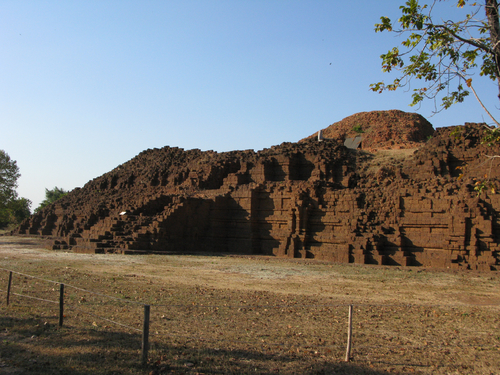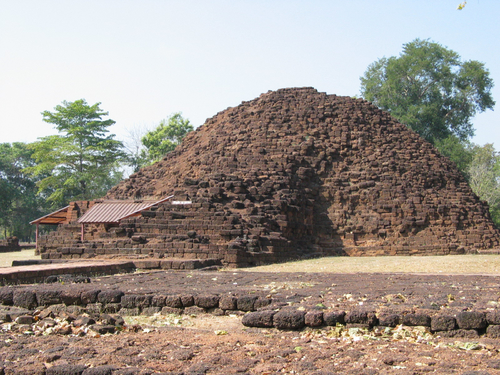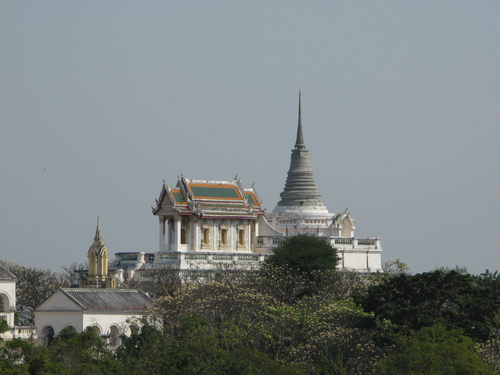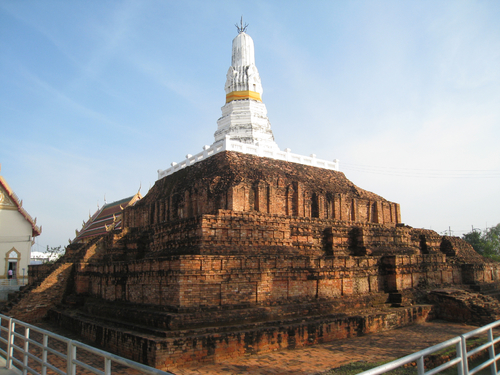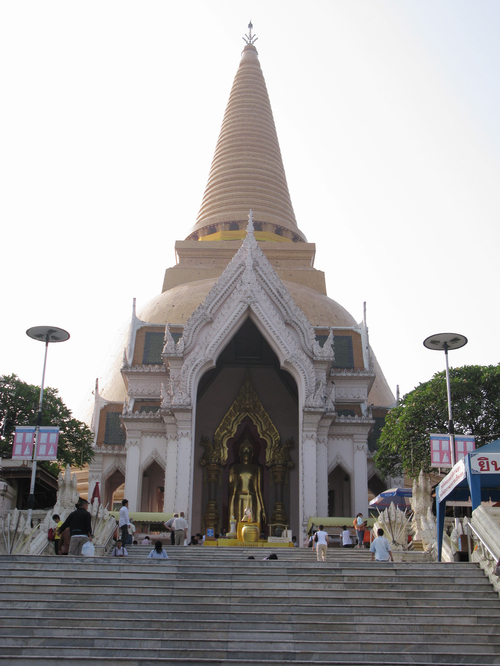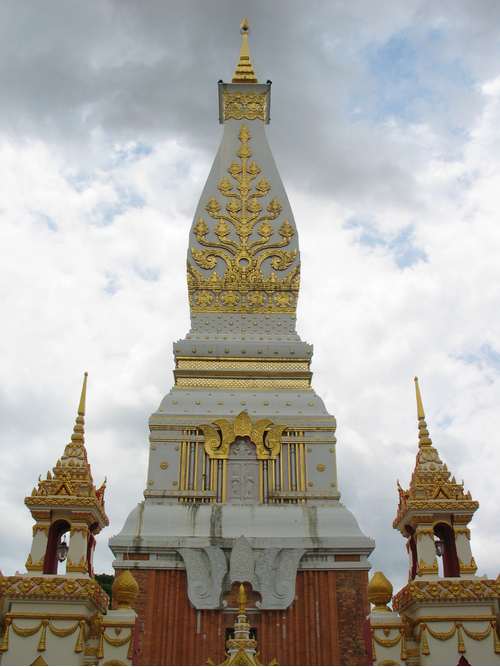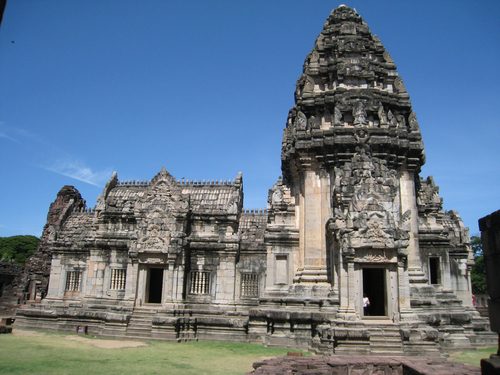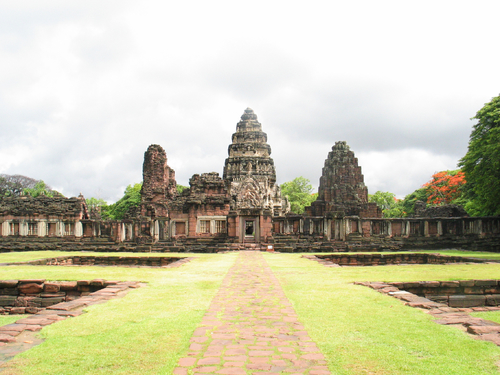ค้นหางานศิลปกรรม
ฐานข้อมูลศิลปกรรมในเอเชียตะวันออกเฉียงใต้
สถาปัตยกรรมเขาคลังนอก
เขาคลังนอกเป็นเจดีย์ที่ใช้ศิลาแลงเป็นวัสดุหลัก ไม่มีปูนฉาบหรือปูนปั้นประดับ เฉพาะองค์เจดีย์ประธานที่ตั้งอยู่บนลานยอดเท่านั้นที่ใช้อิฐเป็นวัสดุหลักเขาคลังนอกมีลักษณะเป็นฐานขนาดใหญ่ซ้อนชั้นกัน บนลานยอดสุดมีเจดีย์ 1 องค์ แผนผังของฐานขนาดใหญ่เป็นสี่เหลี่ยมจัตุรัสยกเก็จ 5 เก็จ โดยแต่ละด้านจะประกอบด้วยเก็จกึ่งกลางที่มีขนาดใหญ่ที่สุด เก็จที่ขนาบเก็จกึ่งกลางมี 2 เก็จขนาดเล็กที่สุด และเก็จที่มุม 2 เก็จ ทุกด้านมีแนวบันไดทางขึ้นสู่ลานยอดพาดผ่านจากเก็จใหญ่ที่กึ่งกลาง ผนังของฐานมีลวดบัวหลายเส้นซ้อนลดหลั่นกัน โดยลวดบัวสำคัญที่แสดงถึงความเป็นศิลปะทวารวดี ได้แก่ บัววลัย หรือกลศ นอกจากนี้ยังประดับตกแต่งผนังของฐานด้วยวิมานหรือปราสาทจำลอง แต่ละด้านมีวิมาน 8 หลังประดับอยู่ที่เก็จขนาบเก็จกึ่งกลาง เก็จมุม และผนังระหว่างเก็จ รูปแบบของลวดบัวทำหนึกถึงลวดบัวในศิลปะปาละตอนต้น ในขณะที่วิมานทำให้นึกถึงศิลปะโจฬะตอนต้น ลานยอดมีเจดีย์ก่ออิฐ 1 องค์ สร้างด้วยอิฐแบบทวารวดีที่ผสมแกลบข้าวในเนื้ออิฐค่อนข้างมาก สภาพปรักหักพังจนศึกษารายละเอียดได้ลำบาก มีแนวหลุมเสากลมล้อมรอบเจดีย์แสดงว่าครั้งหนึ่งเคยมีหลังคาคลุมลานยอดนี้
สถาปัตยกรรมเขาคลังใน
เขาคลังนอกเป็นเจดีย์ศิลาแลง แผนผังสี่เหลี่ยมผืนผ้ายกเก็จ มีบันไดทางขึ้นสู่ลานด้านบนทางทิศตะวันออกสภาพปัจจุบันปรักหักพังมาก หลักฐานที่เหลืออยู่เป็นเพียงส่วนฐานขนาดใหญ่ ไม่ทราบส่วนยอดที่แท้ตั้งหรือรูปแบบอาคารบนลานด้านบนว่าเป็นอย่างไร พบงานปูนปั้นประดับส่วนฐานบ้าง โดยเฉพาะทางด้านใต้ โดยปั้นเป็นรูปคนแคระแบกและพรรณพฤกษา
สถาปัตยกรรมวัดพระแก้วน้อย
สถาปัตยกรรมที่สำคัญของวัดพระแก้วน้อย ได้แก่ พระอุโบสถ และพระสุทธเสลเจดีย์ ส่วนพระอุโบสถเป็นอาคารก่อด้วยหินอ่อนในผังสี่เหลี่ยมผืนผ้า หลังคาประดับกระเบื้องซ้อนชั้น เครื่องลำยองประดับลวดลายปูนปั้นรูปพระมหามงกุฎประดิษฐานบนพานแว่นฟ้า ขนาบสองข้างด้วยฉัตร 5 ชั้น พื้นหลังเป็นลายก้านขด ซึ่งเป็นฝีมือช่างเพชรบุรี ผนังพระอุโบสถเขียนภาพจิตรกรรมลายพรรณพฤกษา ซุ้มประตูหน้าต่างด้านนอกประดับลวดลายปูนปั้น ภายในพระอุโบสถประดิษฐานพระนิรัยตรายจำลองและพระแก้วมรกตจำลองส่วนพระสุทธเสลเจดีย์ เป็นเจดีย์ทรงระฆังตั้งอยู่ด้านหลังพระอุโบสถโดยมีทางเชื่อมต่อขึ้นไปยังฐานประทักษิณรอบองค์เจดีย์ องค์เจดีย์ก่อด้วยหินอ่อนที่รัชกาลที่ 4 โปรดเกล้าฯ ให้ตัดมาจากเกาะสีชัง จ.ชลบุรี เรียงต่อกันตามแบบของเจดีย์ทรงระฆังซึ่งเป็นพระราชนิยม ทั้งนี้ได้โปรดเกล้าฯ ให้มีการบรรจุพระบรมสารีริกธาตุไว้ภายในพระเจดีย์ด้วย
สถาปัตยกรรมพระประโทณเจดีย์
พระประโทณเจดีย์เป็นเจดีย์ก่ออิฐถือปูน ประกอบด้วยส่วนสำคัญ 2 ส่วน ได้แก่ ฐานซ้อนชั้นซึ่งสร้างขึ้นแต่ครั้งทวารวดี และปรางค์ซึ่งตั้งอยู่ด้านบนสร้างขึ้นในสมัยอยุธยา และซ่อมแซมครั้งใหญ่หรือสร้างใหม่ในสมัยรัตนโกสินทร์ฐานซ้อนชั้นมีแผนผังด้านล่างเป็นสี่เหลี่ยมจัตุรัส มีบันไดทางขึ้นที่ด้านทั้งสี่ ถัดขึ้นมาเป็นฐานสี่เหลี่ยมยกเก็จที่กลางด้านและมุมรวม 3 เก็จ องค์ประกอบสำคัญของฐานนี้ คือ บัววลัย และผนังที่ตกแต่งด้วยเสาเป็นระยะ ทำให้พื้นที่ระหว่างเสากลายเป็นช่องสี่เหลี่ยม เสาหรือช่องสี่เหลี่ยมนี้ซ้อนกัน 2 ชั้น โดยชั้นล่างใหญ่กว่าชั้นบน ถัดขึ้นไปเป็นฐานอีกชั้นหนึ่งซึ่งองค์ประกอบหลักไม่ต่างไปจากฐานด้านล่างนัก ยกเว้นทำยกเก็จ 2 ชั้น ฐานชั้นสุดท้ายซึ่งเดิมทีอาจเป็นส่วนเรือนธาตุประดับด้วยซุ้มจระนำเรียงรายโดยรอบ สำหรับปรางค์ที่อยู่ด้านบนสุดมีฐานแปดเหลี่ยมซ้อนชั้นกันต่อด้วยเรือนธาตุเพิ่มมุม ยอดมีลักษณะเป็นแท่งทรงกระบอกตั้งตรงขึ้นไป
สถาปัตยกรรมพระปฐมเจดีย์
พระปฐมเจดีย์เป็นเจดีย์ทรงระฆังในผังกลมที่มีขนาดสูงใหญ่ที่สุดในประเทศไทย ตั้งอยู่บนฐานประทักษิณที่มีระเบียงคดในผังกลมล้อมรอบองค์เจดีย์ โดยมีวิหารทิศทั้ง 4 คั่นจังหวะ ได้แก่ วิหารทิศเหนือประดิษฐานพระพุทธรูปตอนประสูติ วิหารทิศตะวันออกประดิษฐานพระพุทธรูปตอนตรัสรู้ วิหารทิศใต้ประดิษฐานพระพุทธรูปตอนปฐมเทศนา และวิหารทิศตะวันตกประดิษฐานพระพุทธรูปตอนปรินิพพาน องค์พระปฐมเจดีย์ประกอบด้วยส่วนฐานซึ่งเป็นฐานบัวคว่ำบัวหงาย มีส่วนรองรับองค์ระฆังเป็นชุดมาลัยเถารองรับองค์ระฆังขนาดใหญ่ ถัดขึ้นไปเป็นบัลลังก์สี่เหลี่ยม แกนปล้องไฉนที่มีเสาหาร ปล้องไฉน และปลียอดที่มีลักษณะอ้วนป้อม
สถาปัตยกรรมพระธาตุพนม
พระธาตุพนมเป็นเจดีย์ก่ออิฐถือปูน องค์ประกอบสำคัญแบ่งเป็น 2 ส่วน คือ เรือนธาตุ และยอดทรงบัวเหลี่ยมเรือนธาตุก่ออิฐไม่ฉาบปูน มีแผนผังสี่เหลี่ยมจัตุรัส น่าจะตรงกับที่ตำนานอุรังคธาตุเรียกว่า อุโมงค์ (อูบมุง) ประดับตกแต่งกึ่งกลางแต่ละด้านด้วยซุ้มประตูหลอก ถัดออกมาสองข้างของซุ้มประตูตกแต่งด้วยเสาหลอกทรงกลม มุมทั้งสี่สลักภาพกนกพรรณพฤกษาและรูปบุคคลขี่พาหนะ ซึ่งได้รับการเชื่อมโยงเข้ากับตำนานอุรังคธาตุว่าเป็นรูปพระยาทั้งห้าที่ได้ร่วมกันสร้างพระธาตุพนมขึ้น ถัดขึ้นไปเป็นชั้นซ้อนจำลองเรือนธาตุจำนวน 1 ชั้น ถัดไปจากนั้นเป็นยอดบัวเหลี่ยม ส่วนนี้นับได้ว่าเป็นเอกลักษณ์ของศิลปะล้านช้าง
สถาปัตยกรรมปราสาทประธานพิมาย
ปราสาทประธานหรือปรางค์ประธานสร้างจากหินทรายสีเทา หันหน้าไปทางทิศใต้ องค์ประกอบสำคัญได้แก่ เรือนธาตุอยู่ในผังเพิ่มมุม ด้านเหนือ ตะวันออก และตะวันตกของเรือนธาตุเป็นมุขทางเข้าสู่ครรภคฤหะที่อยู่ภายใน ส่วนด้านใต้เป็นอันตราละเชื่อมต่อกับมณฑปสี่เหลี่ยมผืนผ้า มีประตูทางเข้าสู่มณฑปทางด้านใต้ (ในอดีตทางด้านนี้น่าจะมีรูปเคารพ จึงไม่อาจเข้าไปภายในได้จริง) ตะวันออก และตะวันตก ประดับบราลีที่สันหลังคามุข อันตราละ และมณฑปหลังคาของเรือนธาตุเป็นชั้นซ้อนลดหลั่นกัน แต่ละชั้นจำลองย่อส่วนจากเรือนธาตุ ประดับด้วยบรรพแถลงและนาคปัก (กลีบขนุน) ยอดสุดเป็นกลศ นภศูลที่เคยมีอยู่พักหายไปแล้ว ห้องครรภคฤหะที่อยู่ในเรือนธาตุประดิษฐานพระพุทธรูปนาคปรกแบบายน จึงไม่ใช่องค์ดั้งเดิมที่ประดิษฐานพร้อมการสร้างปราสาทประธาน มีรางน้ำมนต์หรือท่อโสมสูตรไหลออกทางมุมทิศตะวันออกเฉียงเหนือ
สถาปัตยกรรมปราสาทพิมาย
ปราสาทพิมายตั้งอยู่ศูนย์กลางเมืองพิมาย หันหน้าไปทางทิศใต้ สิ่งก่อสร้างสำคัญลำดับจากด้านหน้าไปยังปราสาทประธานมีดังนี้1. ชาลานาคราชในแผงผังกากบาท ด้านตะวันตกเฉียงใต้ของชาลานาคราชมีอาคารสี่เหลี่ยม 1 หลัง เรียกกันในปัจจุบันว่า พลับพลาเปลื้องเครื่อง 2. ถัดจากชาลานาคราชเป็นโคปุระและกำแพงล้อมรอบศาสนสถาน โคปุระอยู่ในผังกากบาท ประจำอยู่กึ่งกลางด้านทั้งสี่3. ถัดจากโคปุระทิศใต้ไปเป็นชาลาทางเดินยกพื้น ชาลานี้เชื่อมต่อโคปุระทิศใต้ของกำแพงล้อมรอบศาสนสถานกับโคปุระทิศใต้ของระเบียงคด เดิมทีมีหลังคาเครื่องไม้มุงกระเบื้องคลุมอยู่4. พื้นที่ระหว่างกำแพงล้อมรอบศาสนสถานกับระเบียงคดมีบรรณาลัย 2 หลัง อยู่ทางพื้นที่ด้านตะวันตก นอกจากนี้ยังมีสระน้ำ 4 สระอยู่ที่มุมทั้งสี่ของกำแพงล้อมรอบศาสนสถานด้วย5. ระเบียงคดล้อมรอบพื้นที่ศูนย์กลางอันเป็นที่ตั้งปราสาทประธาน มีโคปุระแผนผังกากบาทอยู่ที่ด้านทั้งสี่ 6. ปราสาทประธานตั้งอยู่กลางศาสนสถาน ก่อด้วยหินทรายสีเทาเป็นวัสดุหลัก หันหน้าไปทางใต้ รอบๆ ปราสาทประธานมีอาคารดังนี้ ด้านตะวันออกเฉียงใต้มีปรางค์พรหมทัต ด้านตะวันตกเฉียงใต้มีหอพราหมณ์และปรางค์หินแดง ด้านตะวันออกมีส่วนฐานของอาคาร 1 หลัง น่าจะเป็นพลับพลาโถง
